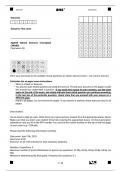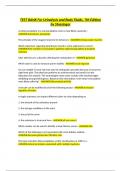0001.pdf 0216415801
Exercises
1 2 3 4 5 6
1 1 1 1 1 1 1
2 2 2 2 2 2 2
Surname, First name
3 3 3 3 3 3 3
4 4 4 4 4 4 4
5 5 5 5 5 5 5
6 6 6 6 6 6 6
Applied Natural Sciences Conceptual
7 7 7 7 7 7 7
(3NAB0)
Final exam Q3 8 8 8 8 8 8 8
9 9 9 9 9 9 9
0 0 0 0 0 0 0
a b c d e f →b
a b c d e f →c
b c d e f →a
Fill in your answer(s) to the multiple-choice questions as shown above (circles = one correct answer).
Particular Ans on paper exam instructions
• Write in a black or blue pen.
• You answer open-ended questions by using the text box. Provide your answers on the papers inside
the answer box underneath a question. If you need more space for your answers, use the extra
space at the end of the exam, and clearly indicate there which question you continue answering.
In the text box of the particular question, clearly state that you proceed with your answer on a
different page.
• Hand in all pages. Do not remove the staple. If you remove it anyhow, check that you hand in all
pages.
Dear student,
You’re about to take an exam. Write down your name and your student ID at the appropriate places above.
Make sure that you enter your student ID by fully coloring the appropriate boxes. On the examination
attendance card, you fill in the PDF number. You can find the correct number on the top of the first page
of your exam (e.g. 1234.pdf).
Please read the following information carefully:
Date exam: April 11th, 2023
Start time 18.00
End time: 21.00 (+30 minutes for time extension students)
Number of questions: 5
Maximum number of points/distribution of points over questions: Q1:28p, Q2:8p, Q3:6p, Q4:8p, Q5:6p; tot.
56p
Method of determining the final grade: 10*points/56 rounded to 0.1
, 0001.pdf 0216415802
Answering style: Q1: multiple choice, Q2-Q5: reasoning/calculation
Permitted examination aids
• Scrap paper (fully blank)
• Non-graphical calculator
• Equation sheet (provided)
Important:
• You are only permitted to visit the toilets under supervision
• Examination scripts (fully completed examination paper, stating name, student number, etc.) must
always be handed in
• The house rules must be observed during the examination
• The instructions of subject experts and invigilators must be followed
• Keep your work place as clean as possible: put pencil case and breadbox away, limit snacks and
drinks
• You are not permitted to share examination aids or lend them to each other
• Do not communicate with any other person by any means
During written examinations, the following actions will in any case be deemed to constitute fraud or
attempted fraud:
• using another person’s proof of identity/campus card (student identity card)
• having a mobile telephone or any other type of media-carrying device on your desk or in your clothes
• using, or attempting to use, unauthorized resources and aids, such as the internet, a mobile telephone,
smartwatch, smart glasses etc.
• having any paper at hand other than that provided by TU/e, unless stated otherwise
• copying (in any form)
• visiting the toilet (or going outside) without permission or supervision
First-year bachelor students: The final grade for this exam will be announced no later than fifteen
working days after the date of this exam, unless this exam takes place in Q4 or the interim period. For Q4
final exams, grades will be announced within five working days after the end of the Q4 final test period. For
interim period final exams, grades will be announced no later than five working days before September 1.
All other students: Generally, the final grade for this exam will be announced no later than fifteen working
days after the date of this examination. Specifically for bachelor exams administered in the interim period,
exam grades will be announced no later than five working days before September 1.
You can start the exam now, good luck!
, 0001.pdf 0216415803
Problem 1 - Multiple Choice questions
2p 1a The escape speed for an object at the surface of the earth is the minimum (vertical) speed the
object should get so that it will not fall back to the earth. The escape speed v is given by
√
8πGρ
v=R
3
with ρ the mass density of the earth (mass per unit volume), R the radius of the earth, and G the
gravitational constant.
The unit of G (expressed in standard SI units) is
a m3/2 /(kg ⋅ s3 )
b kg ⋅ s3 /m2
c m3 /(kg ⋅ s2 )
d kg ⋅ s2 /m3
e m3/2 /(kg ⋅ s2 )
f m2 /(kg ⋅ s3 )
g kg ⋅ s3 /m2/3
h kg ⋅ s2 /m3/2
2p 1b An unstretched, massless spring has length L. An object with mass m is suspended by the spring,
stretching it over a distance ∆L.
Next, the spring with the mass is brought into vertical oscillation. The frequency of oscillation is
measured at f .
How can the acceleration of gravitation g be calculated?
a g = f 2L
b g = (2πf )2 ∆L
c g = (2πf )2 L
d g = f 2 ∆L
e None of the other answers is correct.
2p 1c A racing car starts from rest and reaches a final speed v in a time t. If the acceleration of the car is
constant during this time, which of the following statements is true?
a The car travels a distance vt.
b The acceleration of the car is 21 vt2 .
c The velocity of the car remains constant,
d The car travels a distance 21 vt.
Exercises
1 2 3 4 5 6
1 1 1 1 1 1 1
2 2 2 2 2 2 2
Surname, First name
3 3 3 3 3 3 3
4 4 4 4 4 4 4
5 5 5 5 5 5 5
6 6 6 6 6 6 6
Applied Natural Sciences Conceptual
7 7 7 7 7 7 7
(3NAB0)
Final exam Q3 8 8 8 8 8 8 8
9 9 9 9 9 9 9
0 0 0 0 0 0 0
a b c d e f →b
a b c d e f →c
b c d e f →a
Fill in your answer(s) to the multiple-choice questions as shown above (circles = one correct answer).
Particular Ans on paper exam instructions
• Write in a black or blue pen.
• You answer open-ended questions by using the text box. Provide your answers on the papers inside
the answer box underneath a question. If you need more space for your answers, use the extra
space at the end of the exam, and clearly indicate there which question you continue answering.
In the text box of the particular question, clearly state that you proceed with your answer on a
different page.
• Hand in all pages. Do not remove the staple. If you remove it anyhow, check that you hand in all
pages.
Dear student,
You’re about to take an exam. Write down your name and your student ID at the appropriate places above.
Make sure that you enter your student ID by fully coloring the appropriate boxes. On the examination
attendance card, you fill in the PDF number. You can find the correct number on the top of the first page
of your exam (e.g. 1234.pdf).
Please read the following information carefully:
Date exam: April 11th, 2023
Start time 18.00
End time: 21.00 (+30 minutes for time extension students)
Number of questions: 5
Maximum number of points/distribution of points over questions: Q1:28p, Q2:8p, Q3:6p, Q4:8p, Q5:6p; tot.
56p
Method of determining the final grade: 10*points/56 rounded to 0.1
, 0001.pdf 0216415802
Answering style: Q1: multiple choice, Q2-Q5: reasoning/calculation
Permitted examination aids
• Scrap paper (fully blank)
• Non-graphical calculator
• Equation sheet (provided)
Important:
• You are only permitted to visit the toilets under supervision
• Examination scripts (fully completed examination paper, stating name, student number, etc.) must
always be handed in
• The house rules must be observed during the examination
• The instructions of subject experts and invigilators must be followed
• Keep your work place as clean as possible: put pencil case and breadbox away, limit snacks and
drinks
• You are not permitted to share examination aids or lend them to each other
• Do not communicate with any other person by any means
During written examinations, the following actions will in any case be deemed to constitute fraud or
attempted fraud:
• using another person’s proof of identity/campus card (student identity card)
• having a mobile telephone or any other type of media-carrying device on your desk or in your clothes
• using, or attempting to use, unauthorized resources and aids, such as the internet, a mobile telephone,
smartwatch, smart glasses etc.
• having any paper at hand other than that provided by TU/e, unless stated otherwise
• copying (in any form)
• visiting the toilet (or going outside) without permission or supervision
First-year bachelor students: The final grade for this exam will be announced no later than fifteen
working days after the date of this exam, unless this exam takes place in Q4 or the interim period. For Q4
final exams, grades will be announced within five working days after the end of the Q4 final test period. For
interim period final exams, grades will be announced no later than five working days before September 1.
All other students: Generally, the final grade for this exam will be announced no later than fifteen working
days after the date of this examination. Specifically for bachelor exams administered in the interim period,
exam grades will be announced no later than five working days before September 1.
You can start the exam now, good luck!
, 0001.pdf 0216415803
Problem 1 - Multiple Choice questions
2p 1a The escape speed for an object at the surface of the earth is the minimum (vertical) speed the
object should get so that it will not fall back to the earth. The escape speed v is given by
√
8πGρ
v=R
3
with ρ the mass density of the earth (mass per unit volume), R the radius of the earth, and G the
gravitational constant.
The unit of G (expressed in standard SI units) is
a m3/2 /(kg ⋅ s3 )
b kg ⋅ s3 /m2
c m3 /(kg ⋅ s2 )
d kg ⋅ s2 /m3
e m3/2 /(kg ⋅ s2 )
f m2 /(kg ⋅ s3 )
g kg ⋅ s3 /m2/3
h kg ⋅ s2 /m3/2
2p 1b An unstretched, massless spring has length L. An object with mass m is suspended by the spring,
stretching it over a distance ∆L.
Next, the spring with the mass is brought into vertical oscillation. The frequency of oscillation is
measured at f .
How can the acceleration of gravitation g be calculated?
a g = f 2L
b g = (2πf )2 ∆L
c g = (2πf )2 L
d g = f 2 ∆L
e None of the other answers is correct.
2p 1c A racing car starts from rest and reaches a final speed v in a time t. If the acceleration of the car is
constant during this time, which of the following statements is true?
a The car travels a distance vt.
b The acceleration of the car is 21 vt2 .
c The velocity of the car remains constant,
d The car travels a distance 21 vt.












